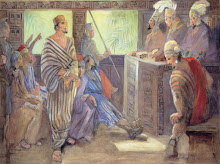Let the Mormon missionaries into your home, and what will they tell you? That in 1820, a young man who was concerned about which religion to join went into the woods to ask God what he should do. God answered his prayer, in fact, God and His Son Jesus Christ made a personal appearance to this boy. This, the missionaries will tell you, constituted the beginning of a new "Gospel Dispensation" or period of time in which God calls a prophet to restore His truth to the earth.
But to the astute student of history it becomes clear that this event was not spoken of widely among early Mormons. In fact, it appears that a large percentage of early Mormons were not aware of this event. Instead, the experience that was publicized, shared, and widely known occurred three and a half years later when the young man, Joseph Smith, had another vision. This time it was not God who appeared, but a being who identified himself as Moroni, an ancient inhabitant of the American continent. Moroni told Joseph that there was a record of his people buried not far from Joseph's home; it is this record which Joseph produced a translation of and called it The Book of Mormon which became the point of interest in the Mormon movement.
Many have questioned why, if it is such a big deal to Mormons today that Joseph saw God and Christ in 1820, the early members of the church placed the emphasis on the vision of Moroni. Terryl Givens suggests in his book By the Hand of Mormon (Oxford University Press, 2002) that in Joseph's first vision "the important truths he learned were that his personal sins were forgiven and that he should hold himself aloof from the sects of his day. Although the timing and the naming of the event assign it absolute primacy in the founding of Mormonism, the vision was described by the young Joseph and apparently interpreted by him at the time as a private experience with no greater implications for the world at large or Christian believers generally" (9-10).
Biblical scholars would call the examination of these facts canonical criticism, i.e. how a sacred text (in this case, the written experiences of Joseph Smith) are used, read, and understood in a community. By extension the question of how much importance is placed on a particular text is considered. Over the 177 year history of the Mormon church, different texts have received varying degrees of attention and emphasis generally and, of course, among individual members. Currently, Joseph's first vision receives more emphasis generally among Mormons. Why this is the case is a question for the Canonical Critics. Suffice it to say, it's rather silly to take the issue of what was emphasized then compared to now and to draw conclusions like, "Therefore, Joseph Smith was not a prophet." The question of relevance screams to be considered.
Monday, December 31, 2007
Subscribe to:
Posts (Atom)
